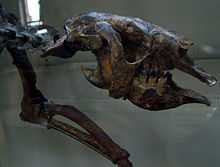Thalassocnus
| Thalassocnus Temporal range: Late Miocene–Late Pliocene | |
|---|---|
 | |
| Thalassocnus skeleton in its hypothetical swimming pose, Muséum national d'histoire naturelle, Paris | |
| Scientific classification | |
| Kingdom: | Animalia |
| Phylum: | Chordata |
| Class: | Mammalia |
| Subclass: | Theria |
| Infraclass: | Eutheria |
| Superorder: | Xenarthra |
| Order: | Pilosa |
| Family: | †Nothrotheriidae |
| Subfamily: | †Thalassocninae |
| Genus: | †Thalassocnus de Muizon & McDonald, 1995 |
| Species | |
| |

Thalassocnus is an extinct genus of apparently semiaquatic (for the geologically oldest species) or fully aquatic (for the geologically most recent species) marine sloth from the Miocene and Pliocene of South America. Fossils found to date have been from the coast of Peru and Chile.[1] They were apparently grazers of sea grass and seaweed. The various species of this genus provides the best-documented case of gradual adaptation to a secondarily aquatic lifestyle. This is documented both at the morphological level, such as a progressive flattening of the radius[2] and at the microanatomical level, which shows a progressive increase in compactness of the long limb bones and ribs.[3] They may have used their powerful claws to anchor themselves to the sea floor to facilitate feeding, similar to the behavior of the marine iguana.[2]
The older species, T. antiquus, T. natans and T. littoralis, show indications of partial adaptation to grazing, with little evidence of transverse mandibular movement while eating, and abundant dental striae indicating ingestion of sand from feeding on vegetation stranded on beaches or in shallow (less than 1 m deep) water. The later species, T. carolomartini and T. yaucensis were apparently specialized grazers that fed in deeper water; they display distinct evidence of transverse mandibular movement and lack dental striae.[2]
| |
| ||||||||||||||||||||||||||||||||||||||||||
| |
Presumed phylogeny of Thalassocnus, with relationship to several nothrotheriines and a megatheriid.[3]
References
- ↑ Canto, J.; Salas-Gismondi, R.; Cozzuol, M.; Yáñez, J. (September 2008). "The aquatic sloth Thalassocnus (Mammalia, Xenarthra) from the late Miocene of North-Central Chile: biogeographic and ecological implications". Journal of Vertebrate Paleontology 28 (3): 918–922. doi:10.1671/0272-4634(2008)28[918:TASTMX]2.0.CO;2. ISSN 0272-4634.
- ↑ 2.0 2.1 2.2 Muizon, C. de; McDonald, H. G.; Salas, R.; Urbina, M. (June 2004). "The evolution of feeding adaptations of the aquatic sloth Thalassocnus". Journal of Vertebrate Paleontology (Society of Vertebrate Paleontology) 24 (2): 398–410. doi:10.1671/2429b. JSTOR 4524727.
- ↑ 3.0 3.1 Amson, E.; Muizon, C. de; Laurin, M.; Argot, C.; Buffrénil, V. de (2014). "Gradual adaptation of bone structure to aquatic lifestyle in extinct sloths from Peru". Proceedings of the Royal Society of London, Series B (Royal Society of London) 281 (1782): 1–6. doi:10.1098/rspb.2014.0192.
- McDonald, H. G.; Muizon, C. de (July 2002). "The cranial anatomy of Thalassocnus (Xenarthra, Mammalia), a derived nothrothere from the Neogene of the Pisco Formation (Peru)". Journal of Vertebrate Paleontology (Society of Vertebrate Paleontology) 22 (2): 349–365. doi:10.1671/0272-4634(2002)022[0349:TCAOTX]2.0.CO;2.
- William F. Perrin, Bernd Wursig, and J. G.M. Thewissen. Encyclopedia of Marine Mammals, Pg.72.
- Muizon, C. de; McDonald, H. G. (1995-05-18). "An aquatic sloth from the Pliocene of Peru". Nature (Nature Publishing Group) 375 (6528): 224–227. Bibcode:1995Natur.375..224M. doi:10.1038/375224a0.
- World Encyclopedia of Dinosaurs & Prehistoric Creatures: The Ultimate Visual Reference To 1000 Dinosaurs And Prehistoric Creatures Of Land, Air And Sea ... And Cretaceous Eras (World Encyclopedia) by Dougal Dixon